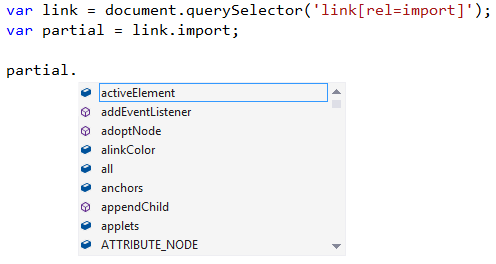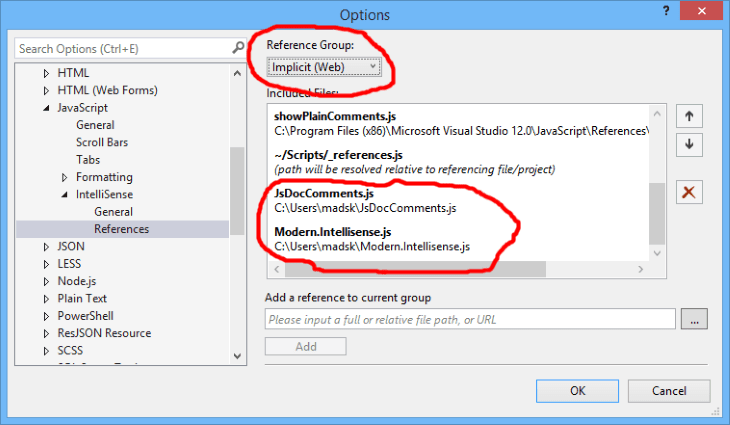Improved JavaScript Intellisense in Visual Studio
The current JavaScript Intellisense in Visual Studio is generated based on IE’s JavaScript engine Chakra and its support for the various browser/DOM APIs. The cool thing about that is that the accuracy is really high, since the good folks on the IE team spends a lot of time implementing the APIs according to the web standard specifications. Awesome!
However, this means that the Intellisense in Visual Studio doesn’t include APIs that IE doesn’t support yet, such as the Shadow DOM, Server-Sent Events, HTML Imports etc.
The good news is that the JavaScript editor in Visual Studio can easily be extended to include Intellisense for all of these APIs. The even better news is that it can all be done in JavaScript.
To do that, we need 2 things:
- Add a JavaScript file to the global Visual Studio references
- Add code to that file containing Intellisense
So let's get started.
Add a .js file to the global references
First of all, we must create a .js file somewhere on disk. Potentially on a network share for your entire team, or just in the user's documents folder. It doesn't matter where.
Then add a reference to it in Tools -> Options like this:
Make sure to chose Implicit (Web) in the Reference Group dropdown. Otherwise it won't take effect for web projects.
Write some Intellisense
Now that the file has been referenced by Visual Studio, we can start adding additional Intellisense to it. Open the newly created .js file as well as any other JavaScript file. We are using the other JavaScript file to test the changes we make to our Intellisense file. We don't have to restart VS to see the changes, just save your Intellisense .js file and the changes take effect immediately.
Let's start by adding support for the new HTML Imports API. It's really simple because it only adds a single new property to DOM elements called import. So an example of how to use it would be something like this:
var link = document.querySelector('link[rel=import]');
var partial = link.import;
The value of partial is a Document element just like window.document. To add Intellisense for the import property, simple add this one line to your Intellisense .js file:
Element.prototype.import = Document.prototype;
We are extending the prototype of the Element object with an import property and giving it the value of the Document object's prototype. So now when we type this into our other JavaScript file, we should see this Intellisense:

What I've found to be a good rule of thumb is to make the added Intellisense apply more broadly than the spec might call for. In the example above, the import property should only apply to <link> elements (HTMLLinkElement), but since VS can't always know what type of element you're referencing, it makes good sense to just make it apply to all elements. It's up to you of course, but I think that this makes for a better experience.
Web Essentials
Today, Web Essentials 2013 ships two .js files that improves JavaScript Intellisense. One adds JSDoc comment support and the other adds many of the missing APIs including support for Angular.js.
The issue is that Web Essentials can't always add those two files to the global references.
If you already have Web Essentials installed, then you already have these two files located in C:\users\yourname\.
The files are:
- JsDocComment.js
- Modern.Intellisense.js
So make sure to check if you already have them in the JavaScript References options:

If not, just add them in the above dialog. The APIs that are added through Web Essentials are:
- Shadow DOM
- Vibration API
- Fullscreen API
- Canvas (improvements)
- Server-Sent Events
- HTML Imports
- Object.observe()
- Angular.js
Contribute
You can help improving the JavaScript Intellisense shipped in Web Essentials by adding support for more APIs to the Modern.Intellisense.js file on GitHub. A great way to get started is to go to status.modern.ie to look for APIs that Internet Explorer doesn't yet support. Under each API there's a link to the W3C specification.
As an added bonus, all of this also applies to Visual Studio 2012, but you have to get the two .js files from Web Essentials 2013 manually since they aren't shipped with Web Essentials 2012.

 3rd-party extensions have never been supported in the free
3rd-party extensions have never been supported in the free